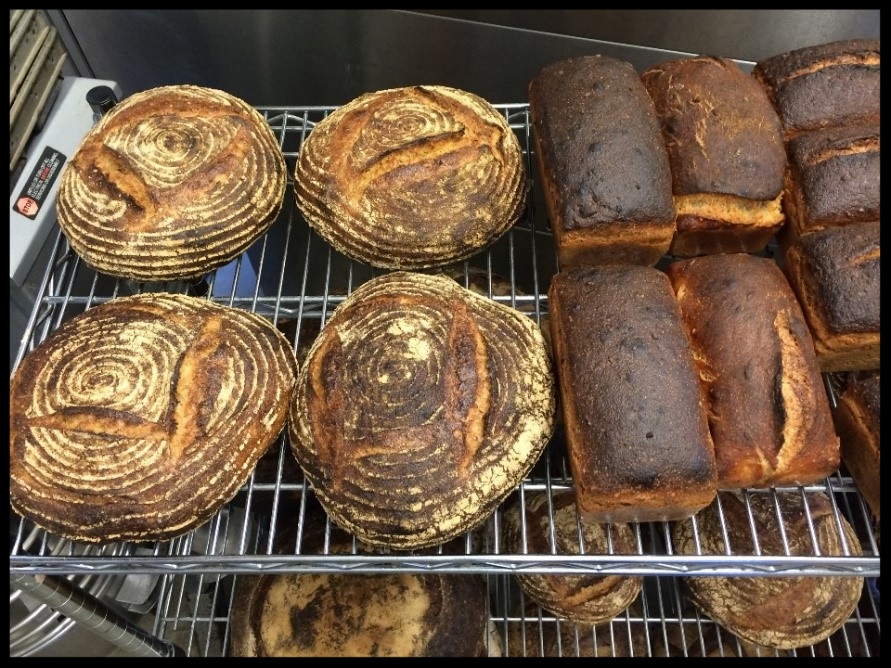Country-Style Breads (Part 3)
This post is the third and final of a three-part series focusing on delicious, wholesome bread recipes that feature our landrace grains. These recipes and many others are included in our newly released updated edition of the Harvest Home Cookbook, available here in both print and eBook versions.
Braided Sweets
The restoration of landrace grains and availability today of identity-specific variety flours also makes possible the customization of time-honored recipes to flavor and texture preferences with consideration of new techniques. At Palouse Heritage we have worked for years to foster “flavorful authenticity” by providing an array of nutritious pre-hybridized landrace grain flours like Crimson Turkey hard red wheat, Sonoran Gold soft white, Yellow Breton soft red, and Purple Egyptian barley. These and other grains arrived from Eurasia during the earliest years of North American colonization to make possible a incredible continental cornucopia.
Blue Hill Restaurant Palouse Heritage Breads, Rockefeller Stone Barns Center for Food and Agriculture; Tarrytown, New York
Ancestral country-bread styles handed down through the ages were not necessarily meant to be unchangeable, fixed lists of ingredients and directions. Now in her hundredth year, spirited Vera Grove Rudd is the eldest member of our extended clan. She was raised at our Palouse Colony Farm and vividly recalls joining her mother to gather hops that grew profusely along the river in order to make a sourdough starter from the naturally occurring yeast that grew on the cones. I have recently learned that this practice was a folk remnant of common practice in medieval times. The hops still grow at the farm in abundance, but times change and Vera came to use store-bought active dry yeast for her country-style breads. As times change so can baking methods and availability of healthy ingredients. Rather like Van Gogh at work on his glowing harvest canvases or Thomas Hart Benton painting Midwest threshing scenes, distinct grain flours serve like paints to enable artisan bakers at home or elsewhere to follow long favored ways, as well as make marvelously new variations.
Although country-style breads have generally been made without eggs, dried fruit, or baked vegetables, these ingredients have long been included by experienced home cooks for special holiday breads. The following recipe from our extended family’s hundred-year-old matriarch, “Miss Vera,” brings to mind her stories of enjoying it every Friday evening when she was a girl living on the family’s Palouse River farm. Recipes like this were popular submission to the many school PTA, church, and social organizations loosely bound cookbook fundraisers. She noted that her mother gathered hop cones every summer for yeast that imparted a unique and wonderful flavor.
Braided Sweet Bread
- 4 cups Palouse Heritage Crimson Turkey Flour
- 3 ½ cups Palouse Heritage Sonoran Gold flour
- ½ cup lukewarm water
- 2 packages active dry yeast
- 1 ½ cups lukewarm milk
- ¼ cup sugar
- 1 tablespoon salt
- 3 eggs
- ¼ cup soft butter
- 2 ½ tablespoons shortening
- crushed walnuts optional
Dissolve yeast in mixing bowl with ½ cup of water. Stir in milk, sugar, and salt. Add eggs, shortening, and half the blended flour. Stir with a spoon, add the rest of the flour, and mix by hand. Turn onto lightly floured board. Knead about 5 minutes until smooth and roll around in a greased bowl. Cover with damp cloth and let rise in a warm place 1 ½ to 2 hours until double in bulk. Punch down, round up, let rise again about 30 minutes until almost a double in volume. Divide dough into 6 parts, making six 14-inch long rolls. Braid 3 rolls loosely, fastening ends. Repeat for second braid. Place on 2 greased baking sheets, and cover with a damp cloth. Let rise 50-60 minutes until almost double in bulk. Heat oven to 425°. Brush braids with glaze of egg yolk and 2 tablespoons of water. May sprinkle with crushed walnuts. Bake 30-35 minutes.










